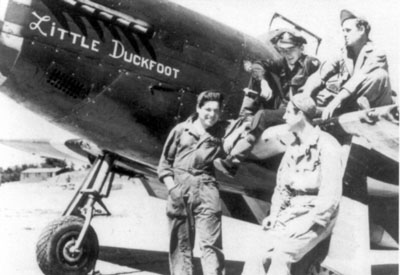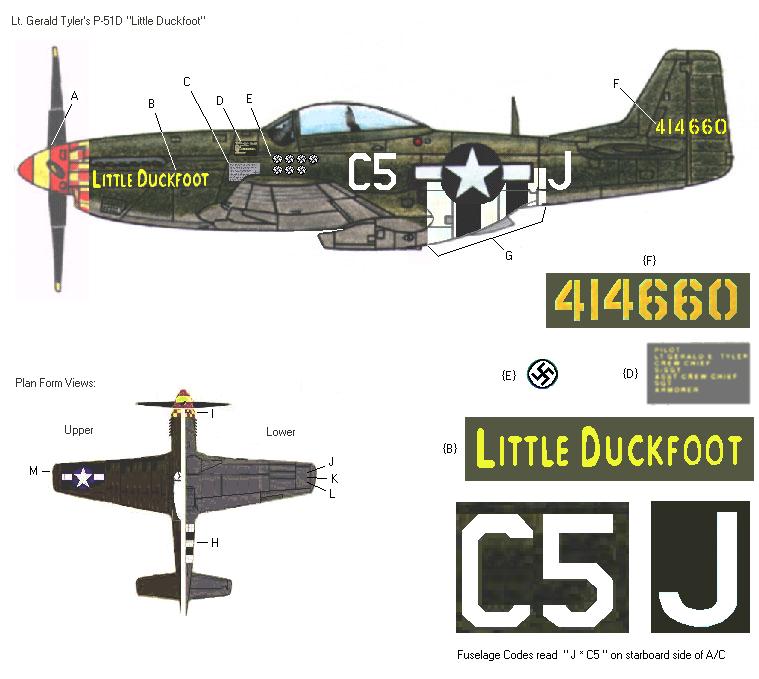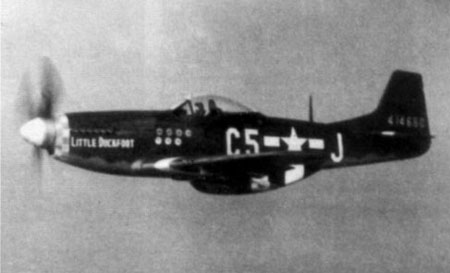357th FG Profile

Gerald Tyler and crew with his P-51B “Little Duckfoot”

Summer 1944
Modeler Tips:
Side View Notes:
A. Rear red band on propeller boss extends onto spinner to leading edge of blades when in neutral pitch. Determine width of yellow band by dividing remainder of spinner evenly.
B. “Little Duckfoot” in yellow rests squarely above lower strip panel seam.
C. Data stencil not overpainted- measure kit decal and mask off rectangular area to paint natural aluminum for stencil background.
D. Name placard for pilot & crew lays along seam with upper right corner nearly touching canopy frame without overlapping it. Note that this version contained only the pilot’s name and crew titles.
E. Kill Marks. 7 black swastikas in white circles bordered in black. 4 in top row, 3 in bottom row. Top row rests squarely beneath panel seam.
F. Tail Number- “414” on fin, “660” on rudder in yellow.
G. Reduced invasion stripes come up to lower edge of star & bar insignia. Sides of radiator ventilation flap were natural metal.
Upper & Lower View Notes:
H. Same as item “G”, above.
I. Width of checker reduced on underside in order to fit evenly on the narrow surfaces of the chin scoop area. J, K, L. Red, Green, Yellow navigation lights- circular and flush with wing panel.
M. Formation Lights- Red (Port) and Green (Starboard)
Overall Modeling Tips:
*This aircraft wore dark olive green over USAAC medium gray. Paint on the flat camouflage colors first- then mask off a rectangle for the project number background and paint in natural aluminum color. Most metal colors will be marred or removed by masking materials so it’s often better to leave them for last.
*No mirror or antenna wires were installed on this aircraft, as with Lt. Fry’s Princess Pat it appears that the white recognition stripes were not re-applied to the horizontal surfaces after D-Day.
*After building several 357th A/C over the past 30 years, I recommend painting the nose area forward of the exhaust cutout yellow when the flat features are painted. When the time for decals arrives, carefully cut away the yellow squares from the checkerboard decal and apply the remaining strip of red checkers to the nose. This method significantly reduces the potential for bubbles, and wrinkles plus it makes exact alignment of the decal easier.
*Prior to assembly, wash clear plastic parts with a mild glass cleaner and gently wipe dry. Then use a Q-Tip to evenly spread clear liquid floor wax (Future Brand seems to get the best results) on both inside & outside. Protect from dust and let dry for at least 2 hours. The wax fills in microscopic flaws and creates an even gloss that is clearer & shines brighter than the original plastic underneath.

1st Lt. Gerald Tyler’s P-51D “Little Duckfoot”
Repli-Scale Decal Sheet 48-5056 and SuperScale Decal Sheet 48-205

